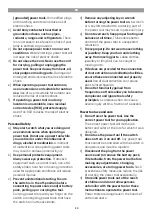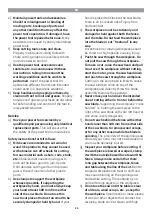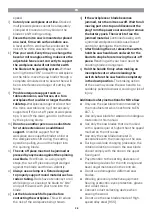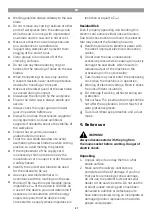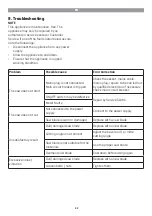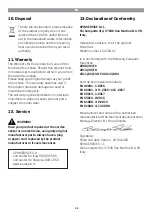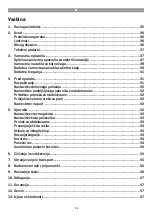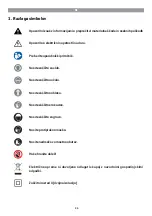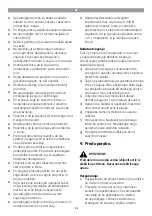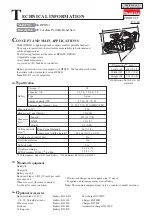
EN
26
speed.
i)
Cut only one workpiece at a time.
Stacked
multiple workpieces cannot be adequately
clamped or braced and may bind on the
blade or shift during cutting.
j)
Ensure the mitre saw is mounted or placed
on a level, firm work surface before use.
A level and firm work surface reduces the
risk of the mitre saw becoming unstable.
k)
Plan your work. Every time you change the
bevel or mitre angle setting, make sure the
adjustable fence is set correctly to support
the workpiece and will not interfere with
the blade or the guarding system.
Without
turning the tool “ON” and with no workpiece
on the table, move the saw blade through a
complete simulated cut to assure there will
be no interference or danger of cutting the
fence.
l)
Provide adequate support such as
table extensions, saw horses, etc. for a
workpiece that is wider or longer than the
table top.
Workpieces longer or wider than
the mitre saw table can tip if not securely
supported. If the cut-off piece or workpiece
tips, it can lift the lower guard or be thrown
by the spinning blade.
m)
Do not use another person as a substitute
for a table extension or as additional
support.
Unstable support for the
workpiece can cause the blade to bind or
the workpiece to shift during the cutting
operation pulling you and the helper into
the spinning blade.
n)
The cut-off piece must not be jammed or
pressed by any means against the spinning
saw blade.
If confined, i.e. using length
stops, the cut-off piece could get wedged
against the blade and thrown violently.
o)
Always use a clamp or a fixture designed
to properly support round material such as
rods or tubing.
Rods have a tendency to roll
while being cut, causing the blade to “bite”
and pull the work with your hand into the
blade.
p)
Let the blade reach full speed before
contacting the workpiece.
This will reduce
the risk of the workpiece being thrown.
q)
If the workpiece or blade becomes
jammed, turn the mitre saw off. Wait for all
moving parts to stop and disconnect the
plug from the power source and/or remove
the battery pack. Then work to free the
jammed material.
Continued sawing with
a jammed workpiece could cause loss of
control or damage to the mitre saw.
r)
After finishing the cut, release the switch,
hold the saw head down and wait for the
blade to stop before removing the cut-off
piece.
Reaching with your hand near the
coasting blade is dangerous.
s)
Hold the handle firmly when making an
incomplete cut or when releasing the
switch before the saw head is completely
in the down position.
The braking action
of the saw may cause the saw head to be
suddenly pulled downward, causing a risk of
injury.
Additional safety instructions for Mitre Saw
●
Only use the saw blade recommended by
the manufacturer which conforms to EN
847-1.
●
Use only saw blade for wood and analogous
materials in this manual.
●
Use only the saw blades that are marked
with a speed equal or higher than the speed
marked on the mitre saw.
●
Use only the saw blade diameter in
accordance with the markings on the saw.
●
During saw blade changing procedure, the
rotation direction arrow on the saw blade
should comply with the one on the upper
fixed guard.
●
Pay attention to the setting devices and
the locking devices for the mitre angle and
bevel angel mentioned in the controls.
●
Do not use damaged or deformed saw
blades.
●
Wearing personal protective equipment:
hearing protection, eyes protection, gloves
and a dust mask.
●
Connect a dust collecting device when
sawing the wood.
●
Do not use the saw blades made of High-
speed alloy steel (HSS).













